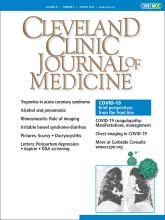
I have correctly diagnosed scurvy several times, missed the diagnosis I do not know how many times, and never treated a patient who had it. This sounds like the beginning of a bad riddle, to which the answer is convoluted. Scurvy, a mimic of vasculitic purpura (pseudovasculitis), has been presented to me at “stump the chump” rounds, although I’ve never diagnosed or treated it in a patient in front of me, and I’m sure over the years I’ve missed diagnosing it in patients with early disease caused by chronic malabsorption, unrecognized alcoholism, or voluntary or imposed dietary restrictions.
Elfeki et al, in this issue of the Journal (page 478), remind us with striking images that ascorbate, which humans cannot synthesize de novo, is necessary to maintain functional collagen needed for the structural integrity of blood vessels and skin. Patients with scurvy may initially describe fatigue and arthralgias, and may also develop anemia, sometimes with iron deficiency.
Like many clinical disorders, scurvy has an interesting medical history. The discovery of citrus fruit as a cure for scurvy (later determined to contain vitamin C) is oft attributed to Dr. James Lind, a surgeons’ mate serving on the HMS Salisbury from 1740 to 1747 during the War of the Austrian Succession. He graduated from the University of Edinburgh with an MD in 1748, a year after he retired from the British Navy. His graduation treatise related to venereal disease, likely a clinical expertise honed from years aboard a ship with many ports of call. Lind published his Treatise of the Scurvy1 in 1753. Within this treatise of 450 pages is “the report of Lind’s controlled trial comparing six purported treatments for scurvy… rather hidden away and [occupying] just four pages, unmarked by a subheading…”2 This has been touted as one of the first randomized, controlled, prospective clinical trials, and it resulted in a treatment to cure (with a number needed to treat of 1). Yet it was tucked away in a manuscript that, despite undergoing several printings including translations to French, German, and Italian, had no immediate impact on the practice of the British Navy.
Lind’s clinical trial was reasonably well conducted. Although there was no apparent sample size power analysis, 12 sailors suffering from a similar degree of scurvy were selected and isolated to the same quarters and given the same food other than their experimental supplementation. There were 30 to 40 men with scurvy for him to choose from (10% of the crew). “Their cases were as similar as I could have them. They all in general had putrid gums, the spots and lassitude, with weakness of the knees.”3
The method of treatment allocation was not clearly stated, but 2 men each were provided 1 of 6 distinct supplements for a planned 14 days: 1.1 L of cider, 25 mL of vitriol (dilute sulfuric acid), 18 mL vinegar 3 times daily, one-half pint of sea water, or 2 oranges and 1 lemon (although apparently the citrus ran out after only 6 days). There was only a historical control group, and there was no defined placebo. There apparently was also no clear scientific hypothesis. Interestingly, there was nautical lore regarding the antiscorbutic properties of oranges dating back to 1498, when Vasco da Gama wrote of providing oranges to his sick sailors, and reaffirmed by John Woodall, Surgeon General of the East India Company in 1617.2
Despite the data from his randomized trial, there is little evidence that Lind himself was convinced enough by the results to lobby the Admiralty to routinely provide citrus to all ships anticipating protracted sea tours. This practice did not occur until 1795, a year after Lind’s death. Lind had apparently suggested that the source of the cure was in the acidity, and limes were initially tried by the Navy (limes were cheaper than lemons, perhaps provided a better group moniker for British sailors, but contained less vitamin C than lemons). Notably, the nutrient value of vitamin C was not recognized until the early 20th century.
Lind’s recognized contribution to medical history and evidence-based medicine was an exemplary randomized clinical trial in the absence of a scientific hypothesis, with positive and lasting results, needing only a sample size of 12. Despite the results of this experiment and his future use of lemon juice to treat scurvy in his civilian practice, he wrote regarding the cause of scurvy: “improper diet, air and confinement, the last of which in particular I now judge to be a principal cause… of the scurvy in long voyages at sea.”1
- Copyright © 2020 The Cleveland Clinic Foundation. All Rights Reserved.






